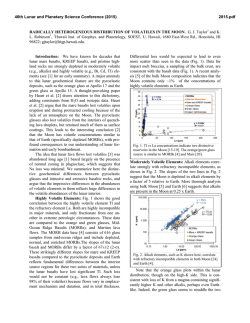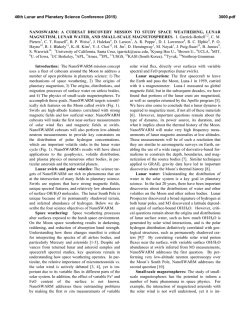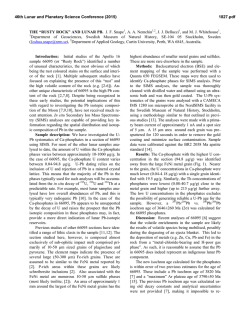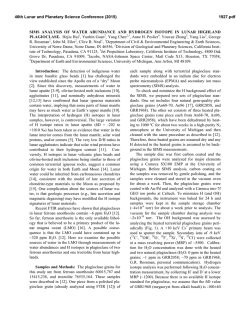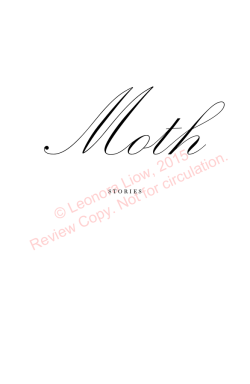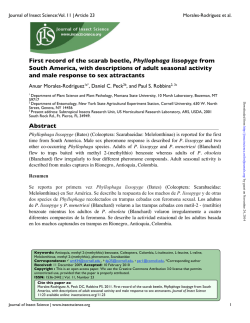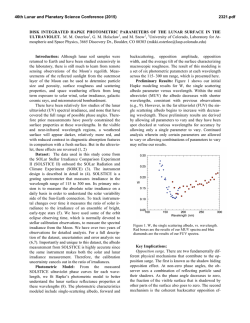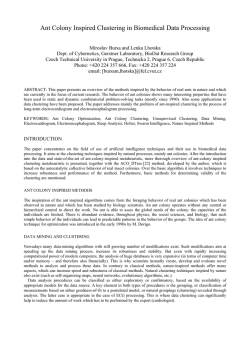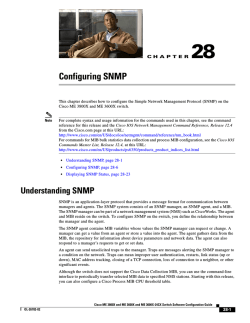
View - ResearchGate
ASIAN J. EXP. BIOL SCI., VOL 1(1) 2010:14-19 © Society of Applied Sciences ORIGINAL ARTICLE The Relationship between Lunar Phases and the Number of Pest Microlepidoptera Specimens Caught by Pheromone Traps 1 L. Nowinszky, 2 G. Barczikay and 3 J. Puskás 1 University of West-Hungary Savaria University Centre, H-9701 Szombathely Károlyi G. Square 4. Correspondence title: H-9700 Forró Street 30. 2 County Borsod-Abaúj-Zemplén Agricultural Office of Plant Protection and Soil Conservation Directorate, H-3917 Bodrogkisfalud, Vasút street. 22. 3 University of West-Hungary Savaria University Centre, H-9701 Szombathely Károlyi G. Square 4. ABSTRACT Between 1982–1988 and 1993–2007 pheromone traps were operating in Borsod-Abaúj-Zemplén County (Hungary). These traps attracted 7 Microlepidoptera species as the follows: Phyllonorycter blancardella Fabr., Anarsia lineatella Z., Lobesia botrana Den. et Schiff., Grapholita molesta Busck, Grapholita funebrana Tr., Cydia pomonella L. and Eupoecilia ambiguella Hbn. We examined the trapping data of these species depending on the moon phases. In case of the European Vine Moth (Lobesia botrana Den.), the Oriental Fruit Moth (Grapholita molesta Busck) and the Codling Moth (Cydia pomonella L.) a catch maximum is detectable in the vicinity of a new Moon. In case of the other 4 species, the catch is higher in the Last Quarter or in the waxing part of the lunation between a Full Moon and a New Moon, than in the waning one (i.e. between a new Moon and a full Moon). In the case of pheromone traps insects do not fly to a light source. The moonlight so may modify it neither the catching distance, neither the flying activity. The recognition that lunar influence is not identical with the influence of moonlight is an important new result of our work. KEY WORDS: lunar phases, pheromone traps, Microlepidoptera, INTRODUCTION Pheromone traps and light traps play an equally important role in pestiferous insect forecast. However, the efficiency of traps may be influenced by several biotic and abiotic factors. As the application of light traps has a past of several decades, thus scientists studied the modifying effect of different factors primarily with the help of light traps. The efficiency of collecting by a light trap is significantly influenced by the Moon. Despite numerous investigations and several interesting results achieved in different parts of the world, opinions on this influence in scientific literature are still quite controversial. Although there are several studies in international scientific literature on the efficiency of pheromone traps and the influence of the Moon, the details of this relationship continue to be less explored. Comprehensive research in this field would be of extreme importance, as the exploration of lunar influence on the efficiency of pheromone traps would also contribute to a better understanding of the relationship between the Moon and light traps. This is because the attracting force of pheromone capsules is not weakened by moonlight. Consequently, any lunar influence detected shall not be explained by the change of collecting distance or the suspected effect of moonlight in decreasing flight activity. Kehat et al. [1] used traps containing live intact females and synthetic pheromone to collect the Cotton Leaf-worm (Spodoptera littoralis Boisduval) on cotton fields in Israel. No correlation between the catch and the lunar phases could be found. ASIAN J. EXP.BIOL.SCI., VOL 1(1)2010 14 Pest Microlepidoptera Specimens Caught by Pheromone Traps Nowinszky et al Collecting with synthetic pheromone traps in Malawi, Marks [2] found that the moonlight had no hindering influence on the collecting of Pectinophora gossypiella Saud. On maize and sorghum fields in western Kenya, in 1981 and 1982 Ho and Reddy [3] caught the following moth species using light traps and pheromone traps baited with intact females: the African White Stem Borer (Maliarpha separatella Rag.), the Spotted Stalk Borer (Chilo partellus Swinh.), the African Sugarcane Borer (Eldana saccharina Wlk.), the African Pink Stem Borer (Sesamia calamistis Hmps.) and the Maize Stalk Borer (Busseola fusca Fuller). They found moonlight to have a stronger influence on the catch by light traps than on the catch by pheromone traps. Hoffmann et al. [4] operated a pheromone trap in California to catch Corn Earworm (Heliothis zea Boddie) and Darker-spotted Straw Moth (Heliothis phloxiphaga Grote & Robinson). Lunation did not have an influence on the timing of catch peaks. Suckling and Brown [5] operated pheromone traps in an orchard in New Zealand between 1989 and 1991, to monitor populations of the Black-lyre Leafroller (Ctenopseustis herana Walker), the Green Headed Leafroller (Planotortrix octo Dugdale), the Codling Moth (Cydia pomonella L.) and the Light Brown Apple Moth (Epiphyas postvittana Walker). Lunation did not have a significant influence. In their pheromone trap experiments focusing on the Scarce Bordered Straw (Helicoverpa armigera Hübner), Sekhar et al. [6] did not observe any difference between the catch at a Full Moon and at a New Moon. The following studies confirm the theory of decreased trapping efficiency of moths in the vicinity of a Full Moon. To record the weekly number of male specimens of Phthorimaea operculella (Zeller), Roux and Baumgartner [7] operated pheromone traps on potato fields in Tunisia between 1986 and 1991. They detected a four-week cycle presumably influenced by the Moon. Operating sex pheromone traps, Parajulee et al. [8] were monitoring the flight activity of the Corn Earworm (Helicoverpa zea Boddie) and the Tobacco Budworm (Heliothis virescens F.) in Texas for 15 years, between 1982 and 1996. The daily catch of the trap was influenced by lunar phases. They revealed a significant positive correlation between the catch and the percentile value of lunar illumination. The maximal daily catch of the trap occurred at a Full Moon (71%), followed by the values of the First Quarter (11%), the Last Quarter (9%) and that of the New Moon (9%). Using pheromone traps, Rajaram et al. [9] collected cotton pests in 1994 in India. They observed a characteristic difference between the nocturnal activity of the week of the Full Moon and the New Moon. The ratio of the week of Full Moon and New Moon was 1:1.40 for the Pink Bollworm (Pectinophora gossypiella Saunders) and 1:1.17 for the Oriental Leafworm Moth (Spodoptera litura Fabr.). However, Das and Katyar [10] studied the pheromone trap catch of the Oriental Leafworm Moth (Spodoptera litura Fabr.) in India. The lowest catch results were recorded in the vicinity of a Full Moon. According to their investigations, collecting is more efficient in the period between a Full and a New Moon than in the period between a New and a Full Moon. Between 1973 and 1990 Sheng et al. [11] operated “Gossyplure” pheromone traps for the Pink Bollworm Moth (Pectinophora gossypiella Saunders) at 10 entomological forecast stations of China. The highest activity was recorded in the First Quarter, resulting in a significant catch peak. Norman Kamarudin and Mohd Basri Wahid [12] used a pheromone trap to collect the Coconut Rhinoceros Beetle (Oryctes rhinoceros L.). Male beetles were more active during a Full Moon. MATERIALS AND METHODS Between 1982 and 1988 pheromone traps were operating in Borsod-Abaúj-Zemplén County (Hungary – Europe) at 9 villages. An additional one trap operated between 1993 and 2007. These traps attracted 7 Microlepidoptera species altogether, in some of the years using 2-2 pheromone traps for each species, however, in other years not all 7 species were monitored. Catch data of the collected species is displayed in Table 1. We examined the trapping data of these species depending on the moon phases. RESULTS AND DISCUSSION Results are shown in Fig. 1 – 6. According to our investigations, the pheromone trap catch of all 6 species is low in the First Quarter and at a Full Moon. In case of the European Vine Moth (Lobesia botrana Den.), the Oriental Fruit Moth (Grapholita molesta Busck) and the Codling Moth (Cydia pomonella L.) a catch maximum is detectable in the vicinity of a New Moon. In case of the other 3 species, the catch is ASIAN J. EXP.BIOL.SCI., VOL 1(1)2010 15 Pest Microlepidoptera Specimens Caught by Pheromone Traps Nowinszky et al higher in the Last Quarter or in the waxing part of the lunation between a Full Moon and a New Moon, than in the waning one (i.e. between a New Moon and a Full Moon). Table 1. Number of examined individuals caught by pheromone trap and number of observing data Species Numbers Individuals 51 805 6 873 20 240 12 673 27 679 9 212 Spotted Tentiform Leafminer Phyllonorycter blancardella Fabricius, 1781 Peach Twig Borer Anarsia lineatella Zeller, 1839 European Vine Moth Lobesia botrana Denis et Schiffermüller, 1775 Oriental Fruit Moth Grapholita molesta Busck, 1916 Plum Fruit Moth Grapholita funebrana Treitschke, 1846 Codling Moth Cydia pomonella Linneus, 1758 Data 1766 1913 2320 2299 3250 2279 Specimens of all the 6 species examined can be collected in various numbers on the different days of the lunar phase. Consequently, the Moon has an influence on the efficiency of the trapping of these species. However, this influence may hardly be attributed to moonlight. In case of light trap studies, the majority of scientists share the view of Williams [13], attributing deviations of the catch during the lunation to smaller collecting distances caused by moonlight or reduced flight activity, perhaps to the behaviour of the moths flying in higher layers of air [14]. Nevertheless, in the case of pheromone traps insects do not fly to a light source, so moonlight may not have a similar influence on this method of trapping. Based on our results, we presume the life cycles of the Microlepidoptera species examined to be somewhat related to lunation. The life of moths is usually short, so there should be some kind of timing factor ensuring that mature specimens find each other. The regularly changing lunar phases seem to be appropriate for this purpose. The proportion of specimens caught on the different days of the lunar month is constant only if the distance between the fruit trees and the trap is constant, as this distance determines the number of moths caught. According to our observations, a trap located 25 metres from the plum-tree collected a large number of Plum Fruit Moth (Grapholita funebrana Tr.) specimens. The other trap, located 150 metres from the same tree started to catch moths only days after the first one and collected only a few specimens. After replacing this trap, closer to the tree, the catch of the two traps became nearly equal. Fig. 1. Pheromone trap catch of the Spotted Tentiform Leafminer (Phyllonorycter blancardella Fabr.) as a function of lunar phases (Borsod-Abaúj-Zemplén County, 1988 and 1993-2007) 1,15 Relative catches 1,10 1,05 The regression equation: y = 0.0006x2 - 0.0158x + 1.0609 R2 = 0.6668 P < 0.001 The catches of New Moon higher then all the other phases P < 0.05 1,00 0,95 0,90 15 -14 -13 -12 -11 -10 -9 -8 -7 -6 -5 -4 -3 -2 -1 0 1 2 3 4 5 6 7 8 9 10 11 12 13 14 15 Lunar phase angle divisions ASIAN J. EXP.BIOL.SCI., VOL 1(1)2010 16 Pest Microlepidoptera Specimens Caught by Pheromone Traps Nowinszky et al Fig. 2. Pheromone trap catch of the Peach Twig Borer (Anarsia lineatella Zeller) as a function of lunar phases (Borsod-Abaúj-Zemplén County, 1985-2007) 1,30 1,20 Relative catches 1,10 1,00 0,90 The regression equation: 3 2 y = -0.0001x + 0.0064x - 0.0661x + 1.0364 2 R = 0.8336 P < 0.001 0,80 Deviation of the catches of ascending phase and descending one of the lunar months is significant P < 0.001 0,70 15 -14 -13 -12 -11 -10 -9 -8 -7 -6 -5 -4 -3 -2 -1 0 1 2 3 4 5 6 7 8 9 10 11 12 13 14 15 Lunar phase angle divisions Fig. 3. Pheromone trap catch of the European Vine Moth (Lobesia botrana Den. et Schiff.) as a function of lunar phases (Borsod-Abaúj-Zemplén County, 1982-2007) 1,15 1,10 The regression equation: y = 0.0005x 2 - 0.0159x + 1.1017 R2 = 0.3084 P < 0.01 Relative catches 1,05 1,00 0,95 0,90 0,85 0,80 15 -14 -13 -12 -11 -10 -9 -8 -7 -6 -5 -4 -3 -2 -1 0 1 2 3 4 5 6 7 8 9 10 11 12 13 14 15 Lunar phase angle divisions ASIAN J. EXP.BIOL.SCI., VOL 1(1)2010 17 Pest Microlepidoptera Specimens Caught by Pheromone Traps Nowinszky et al Fig. 4. Pheromone trap catch of the Oriental Fruit Moth (Grapholita molesta Busck) as a function of lunar phases (Borsod-Abaúj-Zemplén County, 1982-2007) 1,15 1,10 The regression equation: y = -7E-06x3 + 0.001x2 - 0.0265x + 1.1353 R2 = 0.4519 P < 0.05 The catches of New Moon higher then all the other phases P < 0.05 Relative catches 1,05 1,00 0,95 0,90 0,85 0,80 15 -14 -13 -12 -11 -10 -9 -8 -7 -6 -5 -4 -3 -2 -1 0 1 2 3 4 5 6 7 8 9 10 11 12 13 14 15 Lunar phase angle divisions Fig. 5. Pheromone trap catch of Plum Fruit Moth (Grapholita funebrana Treitschke) as a function of lunar phases (Borsod-Abaúj-Zemplén County, 1982-2007) 1,20 1,15 Relative catches 1,10 1,05 1,00 0,95 0,90 The regression equation: 4 3 2 y = -3E-06x + 0.0002x - 0.0015x - 0.0041x + 1.0073 2 R = 0.6526 P < 0.001 Deviation of the catches of ascending phase and descending one of the lunar months is significant P < 0.05 0,85 15 -14 -13 -12 -11 -10 -9 -8 -7 -6 -5 -4 -3 -2 -1 0 1 2 3 4 5 6 7 8 9 10 11 12 13 14 15 Lunar phase angle divisions ASIAN J. EXP.BIOL.SCI., VOL 1(1)2010 18 Pest Microlepidoptera Specimens Caught by Pheromone Traps Nowinszky et al Fig. 6. Pheromone trap catch of the Codling Moth (Cydia pomonella L.) as a function of lunar phases (Borsod-Abaúj-ZemplénCounty, 1982-2007) 1,30 Further, research would be necessary to gain a more comprehensive knowledge on lunar influence also in the case of pheromone traps. The recognition that lunar influence is not identical with the influence of moonlight is an important new result of our work.Similar investigations based on data of traps baited with intact females could be interesting. Through these studies we could get an answer the question of whether the pheromone emission of females is independent of the lunar phases. The catches of New Moon higher then all the other phases P < 0.001 The local maximum after full moon is not significant The regression equation: y = 0.001x2 - 0.0317x + 1.1873 R2 = 0.4925 1,25 1,20 Relative catches 1,15 1,10 1,05 1,00 0,95 0,90 0,85 0,80 15 -14 -13 -12 -11 -10 -9 -8 -7 -6 -5 -4 -3 -2 -1 0 1 2 3 4 5 6 7 8 9 10 11 12 13 14 15 Lunar phase angle divisions REFERENCES [1] [2] [3] [4] [5] [6] [7] [8] [9] [10] [11] [12] [13] Kehat, M., Genizi, A. and Greenberg, S. (1975). The use of traps baited with live females or synthetic pheromone as a tool for improving control programs of the cotton leaf-worm, Spodoptera littoralis (Boisd.), in cotton fields in Israel. Phytoparasitica, 3 (1): 3-18. Marks, R. J. (1976). Field evaluation of gossyplure, the synthetic sex pheromone of Pink Bollworm Pectinophora gossypiella (Saund.) (Lepidoptera, Gelechiidae) in Malawi. Bull. Entomol. Res., 66 (2): 267-278. Ho, D. T. and Reddy, K. V. S. (1983). Monitoring of lepidopterous stem-borer population by pheromone and light traps. Insect Sci. Appl., 4. (1-2): 19-23. Hoffmann, M. P., Wilson, L. T. and Zalom, F. G. (1991). Area-wide pheromone trapping of Helicoverpa sea and Heliothis phloxiphaga (Lepidoptera: Noctuidae) in the Sacramento and San Joaquin Valleys of California. J. Econ. Entomol., 84 (3): 902-911. Suckling, D. M. and Brown, B. (1992): Daily performance of orchard pheromone traps. Proceedings of the Forty Fifth New Zealand Plant Protection Conference, Wellington, New Zealand. pp. 279-284. Sekhar, P. R., Venkataiah, M. and Venugopal, Rao, N. (1995). Effect of moon light and lunar periodicity on the pheromone trap catches of Helicoverpa armigera (Hubner) moths. Annl. Agri. Res. 17 (1): 53-55. Roux, O. and Baumgartner, J. (1995). Potato-tuber moth Phthorimaea operculella (Zeller) (Lep, Gelechiidae) and tuber infestation in Tunisian potato fields - analysis of the flight phenology. J. App. Entomol. Zei.r Ang. Entomologie, 119 (5): 315-319. Parajulee, M. N., Slosser, J. E. and Boring, E. P. (1998). Seasonal activity of Helicoverpa zea and Heliothis virescens (Lepidoptera: Noctuidae) detected by pheromone traps in the rolling plains of Texas. Environ. Entomol., 27 (5): 12031219. Rajaram, V., Janarthanan, R. and Ramamurthy, R. (1999). Influence of weather parameters and moon light on the attraction of light trap and pheromone trap catches of cotton pests under dry farming system. Annal Agri. Res., 20 (3): 282-285. Das, S. B. and Katyar, N. P. (2001). Effect of moon light and lunar periodicity on the pheromone trap catches of tobacco caterpillar (Spodoptera litura Fab.) moths]. Crop Res., 21 (2): 229-236. Sheng Cheng Fa, Wang HongTuo, Wang ShaoLi and Xuan WeiJian (2003). A discussion on the relation between moon phase and moth peak day using Gossyplure. China Cotton, 30 (2): 13-14. Norman Kamarudin and Mohd Basri Wahid (2004). Immigration and activity of Oryctes rhinoceros within a small oil palm replanting area. J. Oil Palm Res., 16 (2): 64-77. Williams, C. B. (1936). The influence of moonlight on the activity of certain nocturnal insects, particularly of the family of Noctuidae as indicated by light-trap. Phil. Trans. Roy. Soc. London. B., 226: 357-389. CORRESPONDING AUTHOR: Prof. L. Nowinszky, University of West-Hungary Savaria University Centre, H-9701 Szombathely Károlyi G. Square 4. Correspondence title: H-9700 Forró Street 30. E-mail:[email protected] ASIAN J. EXP.BIOL.SCI., VOL 1(1)2010 19
© Copyright 2025
